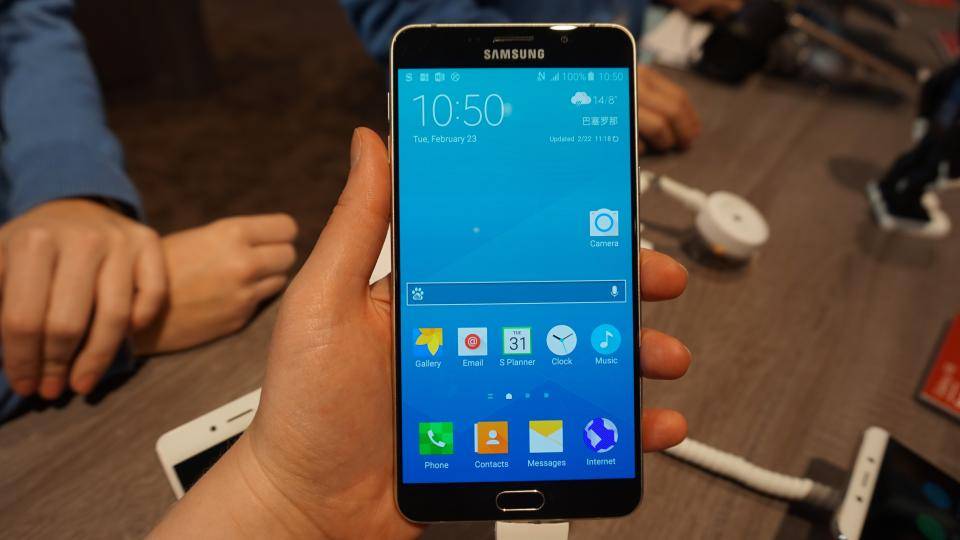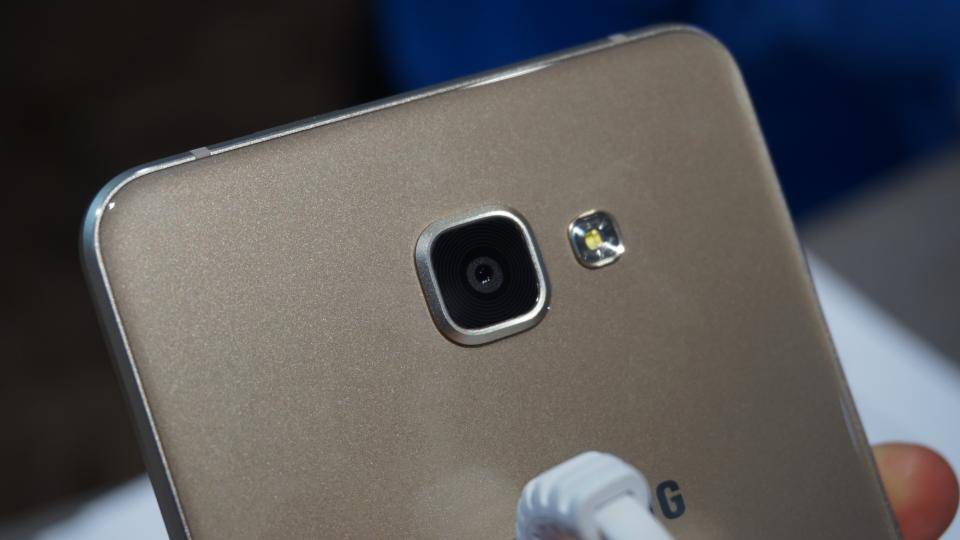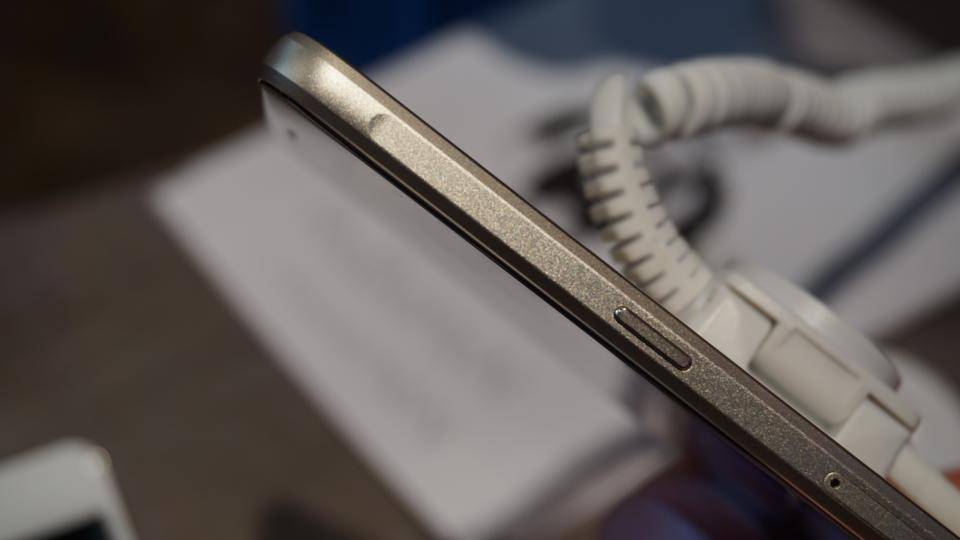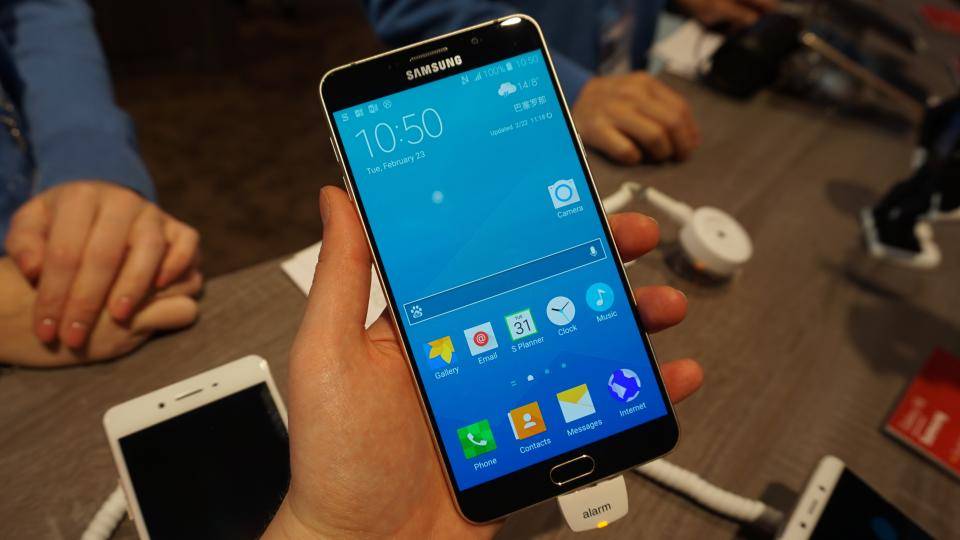Just in case the 5.5in Galaxy A7 isn’t quite big for you, Samsung’s humongous Galaxy A9 should fit the bill. With its massive 6in display, it’s a truly monstrous-sized handset that absolutely dwarfs anything else I’ve seen at this year’s MWC. Measuring 162x81x7.4mm and weighing a hefty 200g, the Galaxy A9 is, quite literally, a real handful to hold, even if you’ve got fairly regular-sized hands.
For instance, I wasn’t able to reach across the other side of the screen with my thumb, and the top of the handset was even more out of reach, which made grappling with it with one hand a real struggle. It doesn’t help that the volume buttons are located right at the top of the left edge either, so you’ll likely need both hands free in order to get the most out of the A9 when you’re out and about.

Thankfully, it’s still fairly easy and comfortable to hold thanks to its angular metal frame. It would have been a nightmare to use if its sides were curved, but luckily its angled ridges provide a decent amount of grip and something to hold on to.
Of course, a phone this size leaves plenty of space for the phone’s battery, and Samsung’s packed in a giant 4,000mAh battery this time round, so it should have more than enough stamina to last you through the day. By comparison, the 2016 version of the A9 only has a 3,300mah, so the A9 should offer a substantial improvement to the phone’s overall longevity.
Inside, the Galaxy A9 is powered by one of Qualcomm’s new octa-core 1.8GHz Snapdragon 652 chips and 3GB of RAM, so it’s very well-equipped when it comes to dealing with multiple apps in Samsung’s Multi Window mode. I’ll have to wait and see how it performs in our benchmarks before I can say how it compares to the rest of Samsung’s 2016 A series, such as the Galaxy A5 , but considering the A7 only has a 1.6GHz octa-core processor, the Galaxy A9 should be the quickest of the lot.
Like the rest of its A series siblings, the A9 has a 13-megapixel rear camera, but it also comes with the added benefit of optical image stabilisation and an aperture of f/1.9. What’s more, its large 1.12um pixels should let in plenty of light. They’re not quite as big as the 1.4um pixels found on the new Galaxy S7 , but they are the same size as the pixels on the Galaxy S6 , which already has one of the best smartphone cameras currently available. If the A9 can match the S6 in terms of picture quality, I’ll be very impressed indeed.

The A9’s screen quality should also be on par with Samsung’s Galaxy S6 and Galaxy S7, as its Super AMOLED screen looked stunning on the show floor, delivering bright, rich colours that had plenty of punch. However, whereas Samsung’s flagships have 2,560x1,440 resolutions, the A9’s screen only has a 1,920x1,080 resolution. This isn’t too surprising given that the A series is meant to be a slightly cheaper option compared to the S series, but it does seem slightly strange given the sheer size of the display.
However, as I found out with the Mate 8 , which also only has a Full HD 6in screen, this isn’t necessarily a recipe for disaster, as you really can’t tell the difference when it comes to overall screen clarity. With a pixel density of 367ppi, the A9 still looked plenty sharp enough when I was swiping through Samsung’s Android 6.0 TouchWiz interface, and I couldn’t see any signs of pixelation or jagged edges on text and app icons either.
You don’t have to worry about storage on the Galaxy A9 either, as it comes with 32GB as standard, but also supports microSD cards up to 128GB.

Samsung’s yet to confirm whether the Galaxy A9 will be coming to the UK, or indeed how much it will cost, but considering the current Note-shaped hole in Samsung’s phablet line-up right now, the A9 could offer a very welcome remedy for those after a proper smartphone tablet hybrid. It’s big enough to offer decent-sized media viewing, and its massive battery should keep it going all day long. I only hope Samsung doesn’t give this one a miss in the UK like it did with the Galaxy Note 5 .

